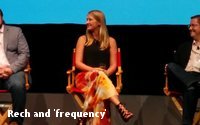Time Emerging As Industry Metric: Big Question Is How Long It Will Take
by Joe Mandese@mp_joemandese, September 22, 2016

Now that the ad industry has come to a consensus that the currency of digital media-buying should be based on human, “viewable” impressions, industry execs are turning their attention to, well, attention. And the time people give to digital advertising. That was the focus of a one-day event in New York City Wednesday — the aptly named Conference on Time and Attention — which also took place, aptly, in Time Inc.’s auditorium in Lower Manhattan.
“It’s something that is evolving,” UM Worldwide Senior Vice President-Digital Innovations and Investment Erin Rech said during a panel examining the media-buying and planning implications of shifting to time-based and attention metrics. “We are learning more and more how not only viewability matters, but time and attention.”
Rech noted that it has already become a factor in “branded content” strategies and executions, and that agencies are just beginning to factor it into media planning and starting to think about how it impacts “your reach and frequency goals.”
Reach and frequency, which are still the foundation of modern media-planning science, are derived from calculating how consumer audiences accumulate and how often individuals are exposed to ad messages based on the number of impressions a campaign delivers and how many people they reach in that media universe — say television, for example.
The problem with that historic model, say the time and attention metric advocates, is that they treat all media impressions equally regardless of the amount of time, or degree of attention consumers give to them.
Rech said classic reach and frequency planning remains “our business deliverable,” but she said time and attention are beginning to emerge as “secondary KPIs,” or key performance indicators that agencies and brands factor into their planning, so they can weight or index the value of time spent with their ad messages.
“Reach and frequency still trumps,” she said.
Bruce Kiernan, practice lead for performance marketing North America at GroupM’s MEC unit, agreed — noting that for GroupM agencies and their clients, so-called “in-view” impressions are still the standard metric for basing its plans and buys, but that “time and attention are a natural extension of that.”
By “in-view,” Kiernan was referring to GroupM’s policy of only buying digital media impressions that are completely in view of the user, but UM’s Rech — as a well as a subsequent Interpublic presenter, Chrystie Kelly, vice president-partner research at IPG Mediabrands — cited a recent IPG study indicating that even ads falling below the industry’s current “viewable” impressions standards can have an impact.
The current industry standard, based on the Media Rating Council’s recommendation that 50% of more of a digital ad must be in view of the user for at least one second for a static ad and two seconds for a video ad, doesn’t give credit to ads that fall below that standard, but still have an impact.
Specifically, the IPG study found that even ads with less than 50% of their pixels in-view could have a significant impact on users, so long as they had a significant amount of time that they were “in-view.” The IPG study indicates that the amount of time in-view could be more important than the percentage of the ad that’s in-view.
The research is another indication that time spent with a brand message may be one of the most important factors going forward. And the biggest unanswered question during the conference, which was produced by Social Summits, is how much time it would take for the industry to adopt that.
While the agency media executives said they are already beginning to factor it into their planning and buying, a panel of marketers indicated there are more pressing matters at hand.
The panel’s moderator, Association of National Advertisers Senior Vice President-Head of Industry Leadership and CMO Initiatives Nick Primola, described the current mindset as a “whack-a-mole” strategy of dealing with the most current problem at hand. While he didn’t explicitly cite burning hot issues like agency media-buying transparency, he did allude to the rapid emergence of ad blockers as one of them.
The brand marketers represented on the panel pretty much concurred that there were more pressing issues at hand, including fraud, transparency and viewability, and that while time and attention are beginning to emerge, it’s likely they won’t really manifest as central issues until some of the immediate ones are resolved.
“Five years ago, we were still looking at clicks and clickthrough rates,” said Caitlin Grigg, director of global digital media & data management at Microsoft, noting that this evolved into “only looking at impressions,” and then more recently to “looking at fraud a viewability.” Now she says, marketers are beginning to “correlate time and attention” so they can “connect more effectively with our consumers.”
She noted Microsoft is already working with some publishers, including the Financial Times, on time-based advertising metrics, but the movement is just starting.
The overall consensus at the conference was that publishers and technology platforms are leading that charge, but it is an important issue for both marketers and agencies.
The big issue going forward, said Marc Guldimann, Founder and CEO of Parsec, a mobile platform that only charges advertisers based on the amount of time users spend with their ads, “is who controls the duration” of time that consumers spend with advertising.
He implied that in the linear advertising media world, it was the media and advertisers, but that in the next phase of digital it would be the consumer and that it would ultimately lead to better engagement between them and the ads they are engaging with.
“When the user is in control of the duration, you can judge the quality,” he said, adding that because it is “opt-in” time spent with the brand’s message, it “becomes much more authentic.”
MediaPost.com: Search Marketing Daily
(9)

